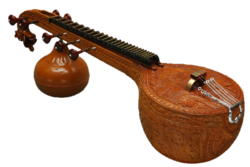
Back Вина (инструмент) Bulgarian বীণা Bengali/Bangla Vina German Vinao Esperanto Vina Spanish وینا Persian Vina Finnish Vînâ French વીણા Gujarati וינה (כלי נגינה) HE
 | |
| String instrument | |
|---|---|
| Other names | Vina[1] |
| Classification | String instruments |
| Developed | Veena has applied to stringed instruments in Indian written records since at least 1000 BCE. Instruments using the name have included forms of arched harp and musical bow, lutes, medieval stick zithers and tube zithers, bowed chordophones, fretless lutes, the Rudra bīn and Sarasvati veena.[2] |
| Related instruments | |
| Chitra veena, Harp-style veena, Mohan veena, Rudra veena, Saraswati veena, Vichitra veena, Sarod, Sitar, Surbahar, Sursingar, Tambouras, Tambura, | |
| Sound sample | |
|
| |
The veena, also spelled vina (Sanskrit: वीणा IAST: vīṇā), is any of various chordophone instruments from the Indian subcontinent.[3] Ancient musical instruments evolved into many variations, such as lutes, zithers and arched harps.[1] The many regional designs have different names such as the Rudra veena, the Saraswati veena, the Vichitra veena and others.[4][5]
The North Indian rudra veena, used in Hindustani classical music, is a stick zither.[1] About 3.5 to 4 feet (1 to 1.2 meters) long to fit the measurements of the musician, it has a hollow body and two large resonating gourds, one under each end.[5] It has four main strings which are melodic, and three auxiliary drone strings.[1] To play, the musician plucks the melody strings downward with a plectrum worn on the first and second fingers, while the drone strings are strummed with the little finger of the playing hand. The musician stops the resonating strings, when so desired, with the fingers of the free hand. In modern times the veena has been generally replaced with the sitar in North Indian performances.[1][3]
The South Indian Saraswati veena, used in Carnatic classical music, is a lute. It is a long-necked, pear-shaped lute, but instead of the lower gourd of the North Indian design, it has a pear-shaped wooden piece. However it, too, has 24 frets, four melody strings, and three drone strings, and is played similarly. It remains an important and popular string instrument in classical Carnatic music.[1][6][7]
As a fretted, plucked lute, the veena can produce pitches in a full three-octave range.[3] The long, hollow neck design of these Indian instruments allows portamento effects and legato ornaments found in Indian ragas.[7] It has been a popular instrument in Indian classical music, and one revered in the Indian culture by its inclusion in the iconography of Saraswati, the Hindu goddess of arts and learning.[6]
- ^ a b c d e f Vina: Musical Instrument, Encyclopædia Britannica (2010)
- ^ Cite error: The named reference
grovekinnariwas invoked but never defined (see the help page). - ^ a b c Dorothea E. Hast; James R. Cowdery; Stanley Arnold Scott (1999). Exploring the World of Music: An Introduction to Music from a World Music Perspective. Kendall & Hunt. pp. 151–152. ISBN 978-0-7872-7154-1.
- ^ Tutut Herawan; Rozaida Ghazali; Mustafa Mat Deris (2014). Recent Advances on Soft Computing and Data Mining. Springer. p. 512. ISBN 978-3-319-07692-8.
- ^ a b Ritwik Sanyal; Richard Widdess (2004). Dhrupad: Tradition and Performance in Indian Music. Ashgate. pp. 23–25. ISBN 978-0-7546-0379-5.
- ^ a b Lochtefeld 2002, pp. 753–754.
- ^ a b Randel 2003, pp. 819–820.